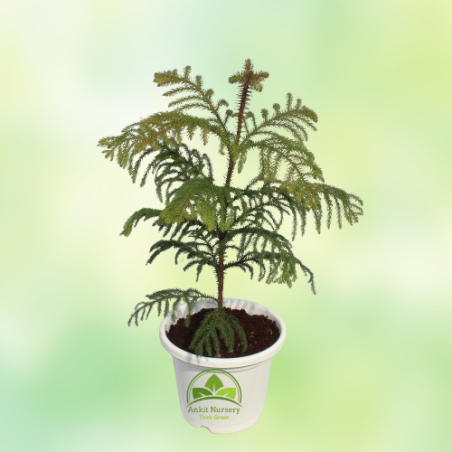
- -10%






The Araucaria plant, also known as the Norfolk Island Pine or simply Araucaria, is a distinctive and popular evergreen tree native to Norfolk Island, located in the Pacific Ocean between Australia and New Zealand. The Araucaria is characterized by its symmetrical, tiered branches and dense, needle-like foliage. The branches typically grow in whorls around the central trunk, forming a pyramid or columnar shape.
In its natural habitat, the Araucaria can grow to be quite tall, reaching heights of up to 200 feet (60 meters). However, when grown as a houseplant or in a container, it typically remains much smaller, usually between 4 to 8 feet (1.2 to 2.4 meters) tall. Araucaria plants prefer bright, indirect light.
Keep the soil evenly moist but not waterlogged. Water the plant when the top inch of soil feels dry to the touch, and allow any excess water to drain away. It's essential to avoid both under-watering, which can cause the foliage to dry out, and overwatering, which can lead to root rot. Avoid placing them in direct sunlight, especially during the hottest part of the day, as this can scorch the foliage. The leaves are dark green and stiff, resembling pine needles. They can tolerate lower light conditions but may become leggy or grow more slowly.
Araucaria plants prefer temperatures between 60-75°F (15-24°C) and moderate humidity levels. They can tolerate average indoor humidity but may benefit from occasional misting or placement near a humidifier, especially in dry indoor environments. Use a well-draining potting mix rich in organic matter, such as peat moss or compost. A mix formulated for houseplants or container-grown trees works well for Araucaria.
Feed your Araucaria plant with a balanced liquid fertilizer diluted to half strength every 4-6 weeks during the growing season (spring and summer). Reduce fertilization in fall and winter when growth slows. Araucaria plants can be propagated from seeds, although they can take several years to mature and may not produce the same characteristics as the parent plant. Alternatively, you can propagate Araucaria from stem cuttings, but this method can be challenging and may not always be successful. Prune Araucaria plants to control their size and shape and remove any dead or yellowing foliage. You can also prune back leggy growth to encourage bushier growth. Araucaria plants are not considered toxic to humans or pets, making them a safe choice for households with children and animals.
Overall, Araucaria plants are striking and relatively low-maintenance trees that can add a touch of exotic beauty to any indoor space. With proper care, they can thrive and be enjoyed for many years.
The term "Silver Yucca" is commonly used to refer to a variety of yucca plants with silvery or...
Ferns are a diverse group of plants known for their delicate, feathery foliage and are...
Sansevieria, is a popular and compact variety of the larger Snake Plant species. It's called...
The Dracaena Compacta, also known as Dracaena deremensis 'Compacta' or Dwarf Dracaena, is a...
The Dracaena Rosea, also known as the Pink Dracaena or Pink Madagascar Dragon Tree, is a...
The Dwarf Snake Plant, scientifically known as Sansevieria trifasciata, is a compact variety...
Rubber Plant - White Pot is a popular and attractive houseplant known for its glossy, deep...
The Saplera plant, also known as Polyscias filicifolia, is a tropical tree native to Southeast...
The Schefflera plant, often referred to as the Umbrella Tree or Schefflera arboricola, is a...
Araucaria is a genus of evergreen coniferous trees and shrubs native to the Southern...
Dracaena victoria, commonly known as the Victoria plant or Victoria dragon tree, is a popular...
The "Croton Yellow" plant likely refers to a variety of Croton (Codiaeum variegatum) with...
Leafy Canna, also known as Canna indica, is a variety of Canna lily that is primarily valued...
Thalia dealbata, commonly known as the Hardy Water Canna. Thalia dealbata is known for its...
The money plant, also known as Devil's Ivy or Epipremnum aureum, is a popular indoor plant...
The Schefflera plant, often referred to as the Umbrella Tree or Schefflera arboricola, is a...